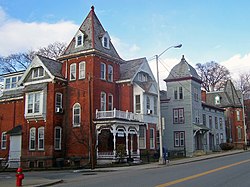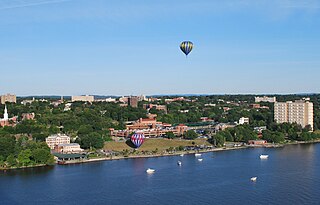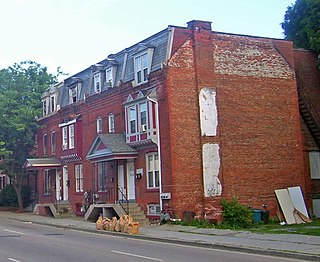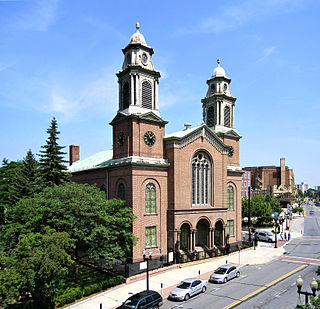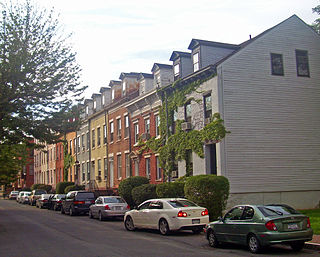Market Street Row | |
Looking north along Market, 2008. Mott-Van Kleeck House is at center. | |
| Location | Poughkeepsie, NY |
|---|---|
| Coordinates | 41°42′02″N73°55′51″W / 41.70056°N 73.93083°W Coordinates: 41°42′02″N73°55′51″W / 41.70056°N 73.93083°W |
| Built | ca. 1780 (Mott-Van Kleeck House), 1880s [1] |
| Architectural style | Federal, mixed late Victorian |
| MPS | Poughkeepsie MRA |
| NRHP reference # | 82001149 |
| Added to NRHP | 1982 |
The Market Street Row is located on the west side of that street in Poughkeepsie, New York, United States, just south of Hulme Park and across from the Adriance Memorial Library, on the southern edge of downtown. It includes three houses, including the Mott-Van Kleeck House, the oldest frame house in the city. [1]

New York is a state in the Northeastern United States, Mid-Atlantic, Great Lakes. New York was one of the original thirteen colonies that formed the United States. With an estimated 19.54 million residents in 2018, it is the fourth most populous state. In order to distinguish the state from the city with the same name, it is often times referred to as New York State.

The United States of America (USA), commonly known as the United States or America, is a country comprising 50 states, a federal district, five major self-governing territories, and various possessions. At 3.8 million square miles, the United States is the world's third or fourth largest country by total area and is slightly smaller than the entire continent of Europe's 3.9 million square miles. With a population of over 327 million people, the U.S. is the third most populous country. The capital is Washington, D.C., and the largest city by population is New York City. Forty-eight states and the capital's federal district are contiguous in North America between Canada and Mexico. The State of Alaska is in the northwest corner of North America, bordered by Canada to the east and across the Bering Strait from Russia to the west. The State of Hawaii is an archipelago in the mid-Pacific Ocean. The U.S. territories are scattered about the Pacific Ocean and the Caribbean Sea, stretching across nine official time zones. The extremely diverse geography, climate, and wildlife of the United States make it one of the world's 17 megadiverse countries.
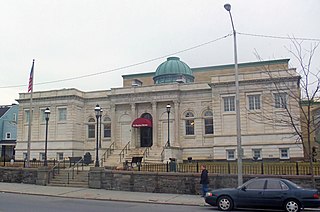
The Adriance Memorial Library is located on Market Street in Poughkeepsie, New York, United States. It is a stone building in the Classical Revival architectural style erected shortly at the end of the 19th century. In 1982 it was listed on the National Register of Historic Places.
Market Street is Poughkeepsie's oldest, in existence in 1709 when a royal decree made it part of the King's Highway, later to become the Albany Post Road after independence. The Mott-Van Kleeck House was built around 1780 by a descendant of the Van Kleeck family, one of Poughkeepsie's oldest. [2] Stylistically it is a precursor to the Federal style, in which later decorative motifs were added. For many years it indicated the beginning of Poughkeepsie to travelers.

The Albany Post Road was a post road – a road used for mail delivery – in the U.S. state of New York. It connected New York City and Albany along the east side of the Hudson River, a service now performed by U.S. Route 9 (US 9).

An architectural style is characterized by the features that make a building or other structure notable or historically identifiable. It is a sub-class of style in the visual arts generally, and most styles in architecture related closely to the wider contemporary artistic style. A style may include such elements as form, method of construction, building materials, and regional character. Most architecture can be classified within a chronology of styles which changes over time reflecting changing fashions, beliefs and religions, or the emergence of new ideas, technology, or materials which make new styles possible.
In the late 19th century, around 1880, the two neighboring houses were built. They were ornate 2 1⁄2-story brick structures with peaked slate roofs, iron cresting, and Shingle-style porches. A tower was added to the Mott-Van Kleeck House, in sympathetic colors and materials. [1]

Slate is a fine-grained, foliated, homogeneous metamorphic rock derived from an original shale-type sedimentary rock composed of clay or volcanic ash through low-grade regional metamorphism. It is the finest grained foliated metamorphic rock. Foliation may not correspond to the original sedimentary layering, but instead is in planes perpendicular to the direction of metamorphic compression.
In the automotive era, Market Street was incorporated into US 9, the main route for drivers from New York City to Albany until the construction of the New York State Thruway and the subsequent rerouting of Route 9 onto a new expressway through the city. The houses became decrepit and were threatened during urban renewal efforts in the 1970s. [1] They were preserved instead, and added to the National Register of Historic Places in 1982. Today they have been redeveloped into commercial offices, [1] like the Hasbrouck House and Amrita Club nearby.

U.S. Route 9 (US 9) is a part of the U.S. Highway System that runs from Laurel, Delaware, to Champlain, New York. In New York, US 9 extends 324.72 miles (522.59 km) from the George Washington Bridge in Manhattan to an interchange with Interstate 87 (I-87) just south of the Canada–United States border in the town of Champlain. US 9 is the longest north–south U.S. Highway in New York; additionally, the portion of US 9 in New York accounts for more than half of the highway's total length.
The New York State Thruway is a system of controlled-access highways spanning 569.83 miles (917.05 km) within the U.S. state of New York. It is operated by the New York State Thruway Authority (NYSTA), a New York State public-benefit corporation. The 496.00-mile (798.23 km) mainline is a toll road that extends from the New York City line at Yonkers to the Pennsylvania state line at Ripley by way of Albany, Syracuse, and Buffalo. According to the International Bridge, Tunnel and Turnpike Association, the Thruway is the fifth busiest toll road in the United States.

Urban renewal is a program of land redevelopment in cities, often where there is urban decay. Urban renewal often refers to the clearing out of blighted areas in inner cities to clear out slums and create opportunities for higher class housing, businesses, and more. Modern attempts at renewal began in the late 19th century in developed nations, and experienced an intense phase in the late 1940s under the rubric of reconstruction. The process has had a major impact on many urban landscapes, and has played an important role in the history and demographics of cities around the world.
